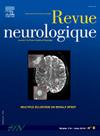研究多发性硬化症神经性疼痛的神经解剖学相关性:一项使用先进MRI技术的初步比较研究。
IF 2.3
4区 医学
Q2 CLINICAL NEUROLOGY
引用次数: 0
摘要
背景:先前的研究探索多发性硬化症(MS)疼痛的解剖学相关性依赖于结构磁共振成像(MRI)和描述性方法。目的:通过对脑MRI的客观分割和分析,建立MS神经性疼痛的影像学相关性。方法:本探索性先导研究包括三组:伴有神经性疼痛的MS患者(n=8)、无疼痛的MS患者(n=11)和伴有小纤维神经病变的患者(n= 6)。使用激光诱发电位(LEPs)确认神经性疼痛,确保疼痛功能的客观评估。所有的参与者都接受了脑部MRI,多发性硬化症患者还接受了脊柱MRI。脑区分割采用SAMSEG (Sequence Adaptive Multimodal segmentation)和SynthSEG两种先进的自动化工具进行。对三组患者的丘脑、脑干、基底神经节、前额叶皮层和体感皮层等与疼痛相关的大脑区域进行了分析和比较。结果:通过SynthSeg而不是SAMSEG测量,疼痛的MS患者的右苍白球体积比无疼痛的MS患者明显减少。感兴趣区域的个体分析显示外囊、内囊、丘脑后辐射和上纵束的弥散张量成像分析结果显著。脊髓病变的定量分析显示两组间无显著差异。结论:这些发现强调了先进的神经成像技术在揭示多发性硬化症神经性疼痛的基于大脑的相关性方面的潜力,尽管需要进一步的更大样本量的研究来验证。本文章由计算机程序翻译,如有差异,请以英文原文为准。
Investigating neuroanatomical correlates of neuropathic pain in multiple sclerosis: A pilot comparative study using advanced MRI techniques
Background
Previous studies exploring the anatomical correlates of pain in multiple sclerosis (MS) have relied on structural magnetic resonance imaging (MRI) and descriptive methodologies.
Objective
To establish radiological correlates of neuropathic pain in MS patients through the objective segmentation and analysis of brain MRI.
Methods
This exploratory pilot study included three distinct groups: MS patients with neuropathic pain (n = 8), MS patients without pain (n = 11), and individuals with small fiber neuropathy (SFN, n = 6). Neuropathic pain was confirmed using laser-evoked potentials (LEPs), ensuring an objective assessment of pain function. All participants underwent brain MRI, with MS patients additionally undergoing spinal MRI. Brain region segmentation was conducted using two advanced automated tools: SAMSEG (Sequence Adaptive Multimodal SEGmentation) and SynthSEG. Pain-related brain regions, including the thalamus, brainstem, basal ganglia, prefrontal cortex, and somatosensory cortex, were analyzed and compared amongst the three groups.
Results
The volume of the right pallidum was significantly reduced in MS patients with pain compared to those without pain, as measured by SynthSeg but not with SAMSEG. Individual analysis of regions of interest showed significant results of diffusion tensor imaging analysis in the external capsule, internal capsule, posterior thalamic radiation, and superior longitudinal fasciculus. Quantitative analysis of spinal cord lesions revealed no significant differences between the groups.
Conclusions
These findings highlight a potential of advanced neuroimaging techniques to uncover brain-based correlates of neuropathic pain in MS, though further studies with larger sample sizes are warranted for validation.
求助全文
通过发布文献求助,成功后即可免费获取论文全文。
去求助
来源期刊

Revue neurologique
医学-临床神经学
CiteScore
4.80
自引率
0.00%
发文量
598
审稿时长
55 days
期刊介绍:
The first issue of the Revue Neurologique, featuring an original article by Jean-Martin Charcot, was published on February 28th, 1893. Six years later, the French Society of Neurology (SFN) adopted this journal as its official publication in the year of its foundation, 1899.
The Revue Neurologique was published throughout the 20th century without interruption and is indexed in all international databases (including Current Contents, Pubmed, Scopus). Ten annual issues provide original peer-reviewed clinical and research articles, and review articles giving up-to-date insights in all areas of neurology. The Revue Neurologique also publishes guidelines and recommendations.
The Revue Neurologique publishes original articles, brief reports, general reviews, editorials, and letters to the editor as well as correspondence concerning articles previously published in the journal in the correspondence column.
 求助内容:
求助内容: 应助结果提醒方式:
应助结果提醒方式:


